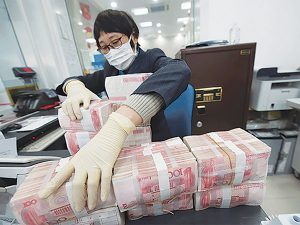Bloomberg
Liquidity in China’s interbank market is more than “reasonably ample,†a senior central bank official said, an indication that further interest rate cuts are unlikely.
The 7-day reverse repurchase rate is around 1.6%, lower than the cost of short-term policy loans the People’s Bank of China (PBOC) provides via its daily open market operations, Zou Lan, the head of the monetary policy department, told reporters in Beijing. The rate on the PBOC’s 7-day loans for lenders is currently at 2.1%.
That suggests “liquidity has stayed slightly more than reasonably ample,†Zou said in answer to a question on whether the central bank will continue to cut interest rates or the reserve requirement ratio for banks.
The PBOC has taken a cautious easing path this year, refraining from cutting policy rates since January. It has instead relied more on structural measures to support targeted sectors such as the property industry, small firms and infrastructure projects, and has pushed banks to lend more. Credit jumped more than expected in June due to a rebound in bank loans and record
government bond sales.
Governor Yi Gang signalled monetary stimulus will likely focus on boosting credit rather than cutting interest rates for the rest of this year, amid concerns over rising inflation and ongoing capital outflows as overseas central banks started tightening policy. All 18 economists polled by Bloomberg expect the PBOC to hold the rate on its one-year policy loans.
“We see the rate cut window already shut,†said Ding Shuang, chief economist for Greater China and North Asia at Standard Chartered Plc. Zou’s answer “also suggests that the possibility for a RRR cut is pretty low.â€
The PBOC is keeping a close eye on domestic inflation as well as shifts of monetary policies in major economies, Zou said. The central bank has taken preemptive measures to offset the impact of changes in the external environment on cross-border capital flows and continues to base its policy-making mainly on domestic issues, he said.
With the economy showing early signs of recovery in June as Covid outbreaks and lockdowns eased, the PBOC has slashed its liquidity injections in the daily open-market operations since the start of July. That’s sparked speculation that it’s moving towards normalising interbank cash conditions. Previously it kept liquidity flush from April as the virus spread, creating a glut of cash that wasn’t able to make its way to the real economy.
“The economy has bottomed out since May as domestic Covid outbreaks eased†while the government accelerated the roll-out of pro-growth policies, Zou said. The PBOC will maintain the strength of credit support to help corporate and household balance sheets to improve, he said.
He cautioned that “arduous efforts†are still needed to consolidate the rebound, which faces “relatively big uncertainty†in the second half of the year.
The central bank will enhance the implementation of already-announced policies such as the 1.1 trillion yuan ($164 billion) in additional policy bank funding for infrastructure, he said, which includes 300 billion yuan of financial tools the lenders will set up with funds raised through bond sales. The financial tools are expected to account for up to 10% of total investment in relevant projects, he added.
The PBOC has also reserved “sufficient†policy room and tools to tackle “unexpected new challenges,†Zou said.
Separately, Sun Tianqi, head of the PBOC’s financial stability bureau, said at the same briefing that a recent evaluation by the central bank found 316 high-risk lenders, including some rural banks in Henan province involved in a financial scam. Assets of the risky banks account for just 1% of the sector’s total, meaning the vast majority of Chinese lenders are safe, he said.
 The Gulf Time Newspaper One of the finest business newspapers in the UAE brought to you by our professional writers and editors.
The Gulf Time Newspaper One of the finest business newspapers in the UAE brought to you by our professional writers and editors.
